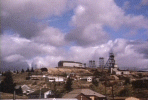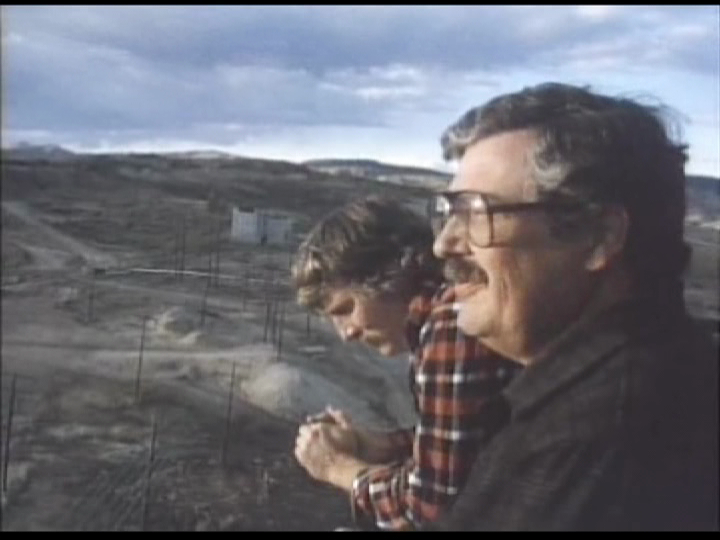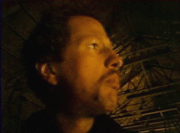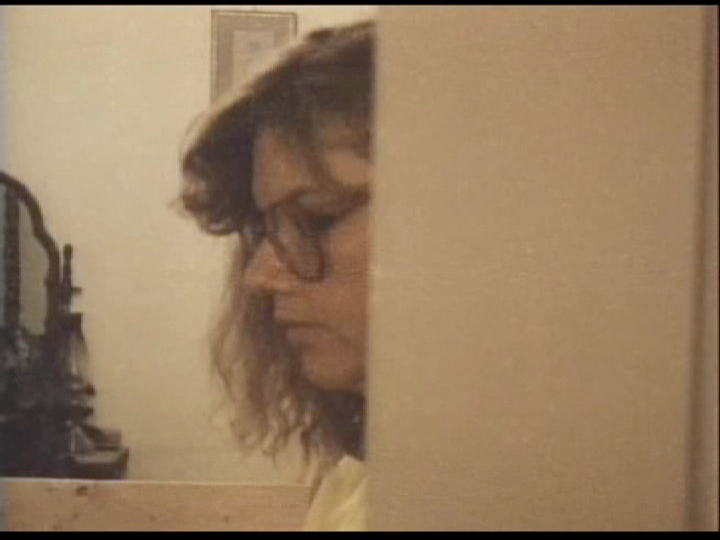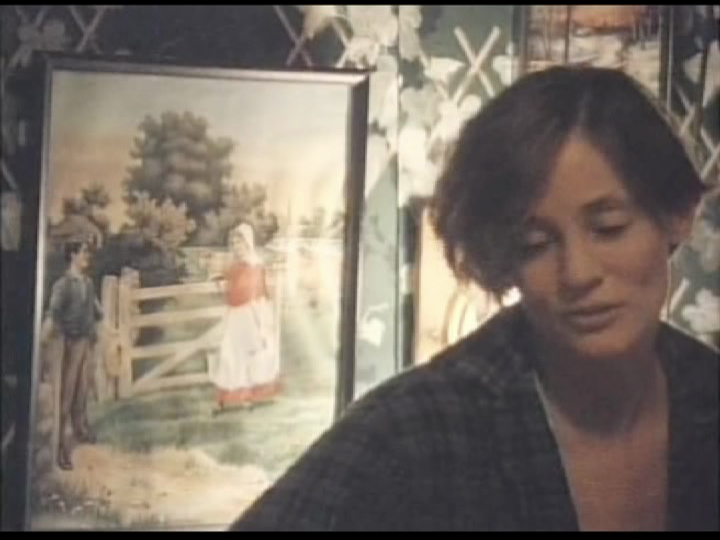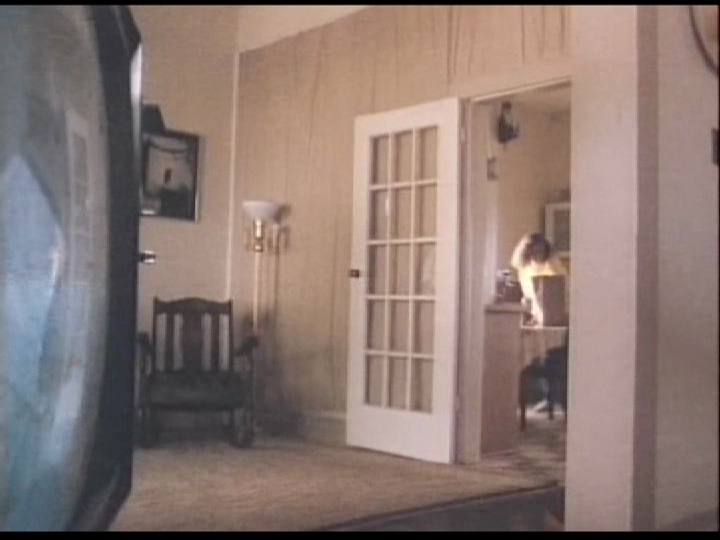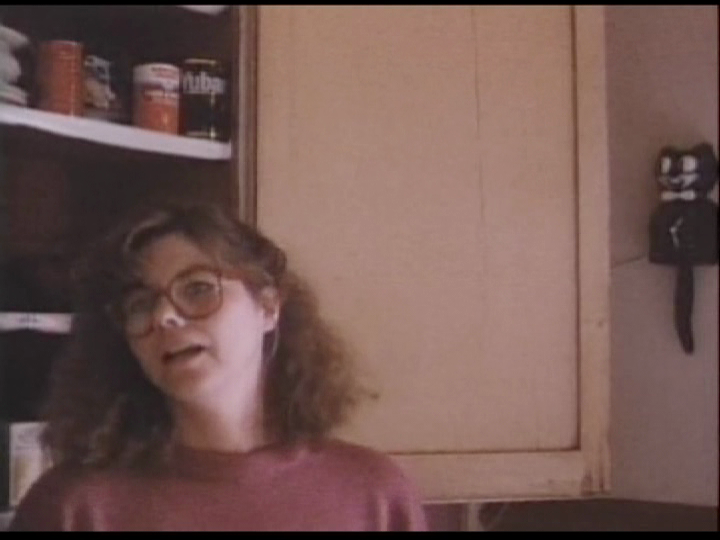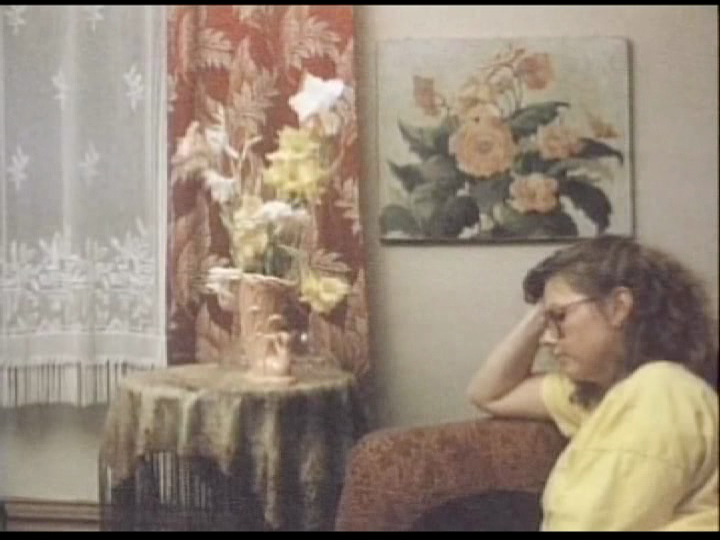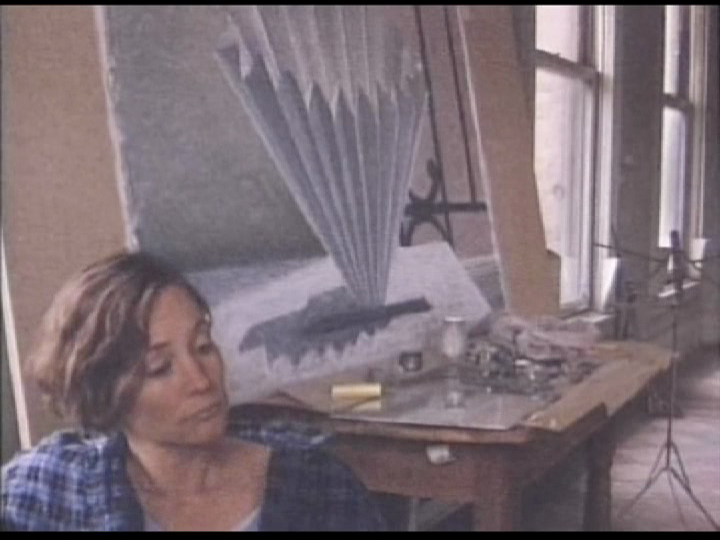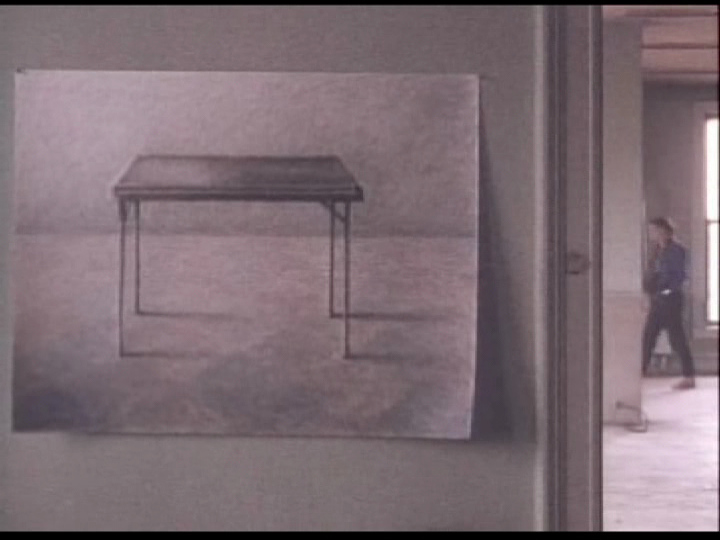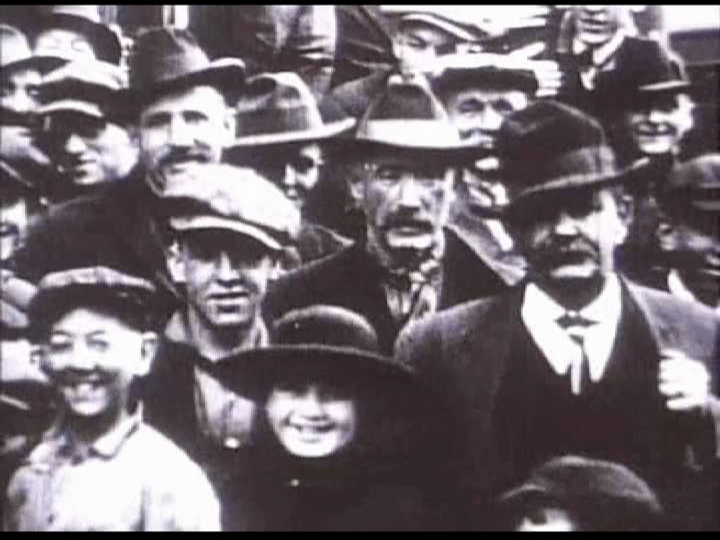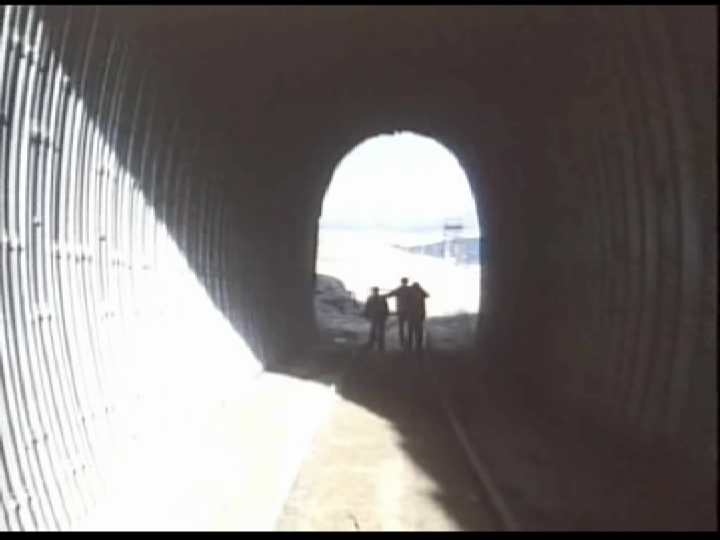From the Chicago Reader (December 11, 1987). — J.R.
BELL DIAMOND
*** (A must-see)
Directed by Jon Jost
With Marshall Gaddis, Sarah Wyss, Terri Lyn Williams, Kristi Jean Hager, Dan Cornell, Hal Waldrup, Ron Hanekan, Alan Goddard, and Anne Kolesar.
The films I most eagerly look forward to will not be documentaries but works of pure fiction, played against, and into, and in collaboration with unrehearsed and uninvented reality. — James Agee
1. Jeff Doland (Marshall Gaddis), a Vietnam veteran in Butte, Montana, sits watching a baseball game on TV. Passing through the kitchen, he tells his wife Cathy (Sarah Wyss) that he’s going out to pick up some more beer. Cathy continues to unpack groceries and switches on a tiny toy train that runs in an elaborate loop on the kitchen table. Jeff returns with a six-pack and resumes watching TV. Cathy comes into the room and announces that she’s leaving him.
Bell Diamond‘s point of departure is about as ordinary and as banal as a plot can get — and not much happens after it, either. Neither Jeff nor Cathy is especially interesting or attractive or articulate, and the same can be said of the rest of the characters in this mainly eventless movie. We learn that Cathy leaves Jeff because she’s frustrated by their inability to have kids, although she also complains about his passivity and inactivity, including his failure to perform household chores. Much later, it’s suggested that Jeff’s apparent sterility has been caused by Agent Orange — a chemical spray used to kill vegetation in Vietnam with various adverse side effects, none of them acknowledged by the government — but the film doesn’t explain this, and nothing further is said about it.
Jeff drinks a lot after Cathy leaves him, and a lengthy middle sequence shows him wandering drunkenly and morosely with a couple of male friends around an abandoned copper mine called Bell Diamond. They climb up a towerlike structure, a “head-frame,” to watch the sunset, and Jeff starts to sob. Then, through a casual chain of events, one of the friends — another Vietnam veteran — leaves and tells a mutual friend about Jeff’s troubles. The latter phones a radio call-in show to report that Jeff is about to jump off the head-frame (which is when Agent Orange gets mentioned); then a friend of Cathy’s calls her to tell her that another female friend heard this on a radio show — but nothing ever comes of this, either, and the sequence ends with Jeff and another friend sharing a joint on the head-frame and hearing a distant siren.
Several months later, when Cathy returns to Jeff, she’s visibly pregnant, but whether the child is his or someone else’s is not spelled out: the film simply concludes with the pleased expressions of each of them in turn as she steps off the bus.
2. Not one shot of Bell Diamond is conventional, a cliché, or something we’ve all seen before. The first one shows Jeff in medium-shot watching an unseen TV with a glassy-eyed expression while chewing on something incessantly and taking sips from a beer can. The shot is held for a very long time, long enough to establish a certain tension about what or who it is we’re watching. He’s a spectator just like us, but is it possible to identify with him? Is he chomping on gum, or is it chewing tobacco? And either way, how do we feel about the fact that he’s guzzling beer at the same time — slightly nauseated, or indifferent? Are we watching an art film or an indiscriminate slice of life? Is the filmmaker making a comment on what he’s showing, or obliging us to do so instead? Should we keep watching, or listen to what the offscreen TV announcer is saying, or attempt some combination of the two? And if it’s the latter, how do we put that sound together with that image?
Then a reverse-angle of the baseball game is superimposed over the previous shot, and eventually the TV image takes over and Jeff fades away. It’s as if spectator and spectacle had merged into the same substance — as if a baseball game, a TV screen, and a man watching the former through the medium of the latter had all become identical, equivalent, or interchangeable. (Those viewers fortunate enough to have seen Jon Jost’s 1977 fiction feature Last Chants for a Slow Dance might be reminded of a much longer take there involving a TV screen — an extraordinary shot that runs for about 14 minutes, charting simultaneously the events and changes of light visible in a room over 12 hours, from night to morning, in black and white, and a continuous 14-minute segment of the Tonight Show on the TV set in the room, in color; when the characters in the room eventually walk past the TV screen, The Tonight Show shines right through them, as if they were transparent ghosts.)
The next shot in Bell Diamond shows Jeff watching the TV screen from a greater distance. Then there is a cut to an angled side view that allows us to see past the slanted TV screen, into the adjacent living room, and beyond that into the kitchen where Cathy is unpacking groceries. A closer, fragmented shot of Cathy, framed below her shoulders, is succeeded by an angle showing both the TV and Jeff, who gets up and leaves the frame.
So much for the film’s first half-dozen shots, if I’ve remembered them correctly; the ones that follow are no less inventive and unexpected. Even the slurred step-motion and freeze-frames that comprise our final glimpses of Cathy and Jeff, reunited at the bus stop at the end in separate shots, are not the kind of slurred motion and freeze-frames that we recognize from other movies.
3. My point in juxtaposing 1 and 2 above is not that the fascination of the shots triumphs over or transcends the banality of the plot, or that the plot’s banality defeats the images. In fact, if I gave enough thought to it, I could probably demonstrate with an equal amount of evidence that the plot of Bell Diamond is original and unpredictable, while the images and editing are stale rehashes of things found elsewhere in the narrative art cinema. My point, rather, is that Jost’s handcrafted movies, Bell Diamond included, not only raise issues but stage them, right in the spectator’s head, and that they don’t go down easily — nor are they meant to. “In all my films, I’m always testing the limits of the audience,” Jost told me in an interview about six years ago, referring to the five features and more than 20 shorts he had made since the 60s. He has held to this brief in the three features he has completed since then — Slow Moves in 1983, and Bell Diamond and Uncommon Senses in 1987.
With Slow Moves (which also featured Marshall Gaddis in the male lead), Jost inaugurated the practice followed here of developing the story and dialogue in collaboration with a cast of improvising nonprofessionals. He shot Slow Moves in three and a half days in the San Francisco Bay area, bringing together a couple who had never met before the film’s opening shot and creating their fictional relationship on the spot. Uncommon Senses (which Chicago Filmmakers plans to show next year, after they’ve moved into their new headquarters) is an essay film conceived as a sequel to Jost’s remarkable first feature, Speaking Directly (1974); each film is a sort of personal State of the Union address, articulated filmically through a variety of means.
4. All of Jost’s films are made with rock-bottom budgets and are conceived accordingly, aesthetically and otherwise. Bell Diamond was made for $25,000, which came from the National Endowment for the Arts, and if I’m not mistaken it’s the first Jost film funded by a grant in the U.S. All the others — including the staggeringly frugal Speaking Directly and Last Chants, which cost $2,500 and $3,000 respectively — have been paid for by private sources or European television, and during much of the time that he was working on them, Jost was living out of his car and distributing the films himself. As an independent, in other words, he makes Jim Jarmusch look like Sam Goldwyn. He works in 16 millimeter, a film gauge that is rapidly becoming extinct as far as most labs are concerned; he doesn’t expect to be able to continue in the format much longer.
5. Out of all the forms of conditioning that the legacy of Hollywood and TV has imprinted on our brains, perhaps the most enduring is the myth that realism is some sort of found object rather than a construction. The notion that whatever a camera catches is “real” is still very much with us, despite the fact that camera placement, choices of lens and exposure, and the kind of lab work done on the footage afterward — not to mention the recording and processing of sound, and the editing of sound and image — all represent aesthetic and stylistic decisions. We still speak of certain films being “stylized,” as if it were possible for any film to be otherwise.
Some of our confusions about this can be traced back to certain assumptions about the aesthetic differences between photography and painting, assumptions that are built into our language: we “take” snapshots, but we “make” works of art. In truth, of course, a photograph is as “made” as a painting is, and — to compound the confusion — our very notions of “reality” are as man-made and historically determined as the properties of screens and canvases (as well as cameras and paints).
One of the most striking sequences in Bell Diamond, when Cathy visits Laura (Kristi Jean Hager), a painter friend, in her studio, throws some of these issues into sharp relief. While the two women chat about a number of things, initially avoiding any discussion of Cathy’s recent separation from Jeff, Cathy leafs through a book of Thomas Eakins reproductions, and Laura’s comments about Eakins seem to point to various aspects of Jost’s filmmaking. “He did wonderful portraits,” she says, but goes on to note that a lot of people didn’t like them because he didn’t flatter his subjects; he showed people working at their various occupations, and he liked photography as well as painting.
While they speak, the camera performs an elaborate dance around the studio, picking up the characters only momentarily, and at times lingering on parts of the room after the women have left the frame. As if to cinch the relationship between photography and painting, the camera steadily approaches an empty canvas until its white expanse approximates the movie screen, and Jost cuts from this to archival footage shot in Butte around 1920, a 360-degree pan across a crowd of locals looking directly into the camera — another scene to match Eakins.
6. In some respects, the movement of the camera in Laura’s studio duplicates the movement of the plot in Bell Diamond — a form of wandering that actually takes us somewhere, even if that somewhere happens to be miles away from what we normally recognize as Hollywood narrative. A constructed realism that remains open to accident, and seems founded on a distanced respect for unexceptional characters, it is a handcrafted movie that won’t find many viewers in a universe of shopping malls. To represent such an art in a few words and pictures is no easy matter; certainly the beauty and originality of Jost’s camera style are inadequately served by the grainy still that accompanies this review. To wrestle with it on the screen is not always a picnic either. But unless or until this kind of filmmaking is ground underfoot entirely by high-priced fantasies that cost many thousand times as much, Jost’s cinema will convey truths about this country that won’t readily be found elsewhere.

